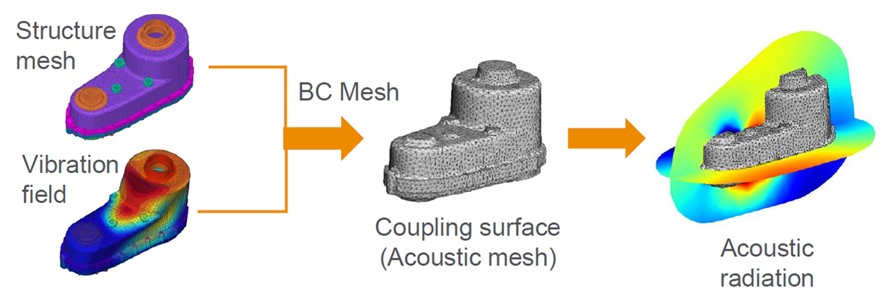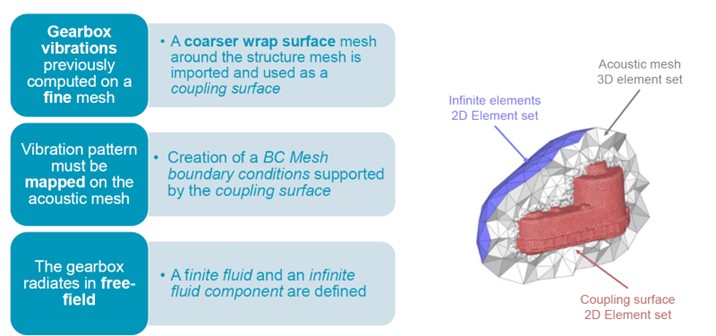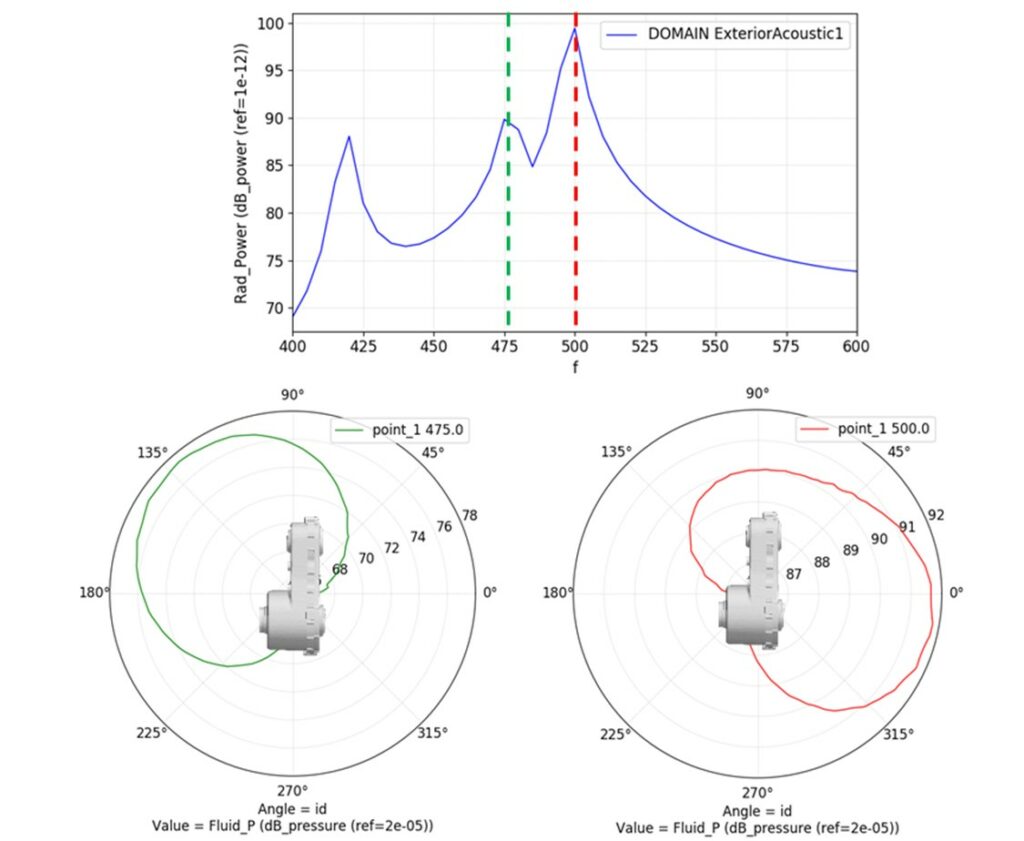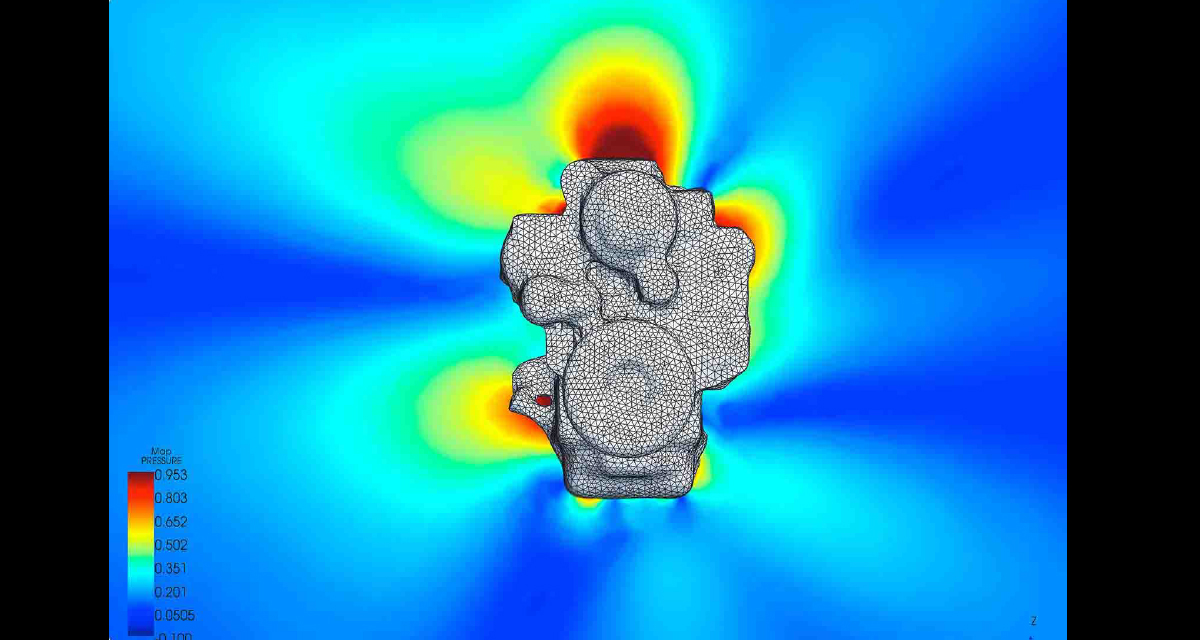變速箱的聲音輻射 – CAE軟體Actran 向大家介紹如何使用Actran完成變速箱在自由聲場中的聲音輻射。我們將從基礎開始,講解如何建立一個完整的 Actran 模型,並利用現有的振動結構數據進行聲學模擬與分析。同時,介紹 BC Mesh 邊界條件,讓用戶們熟悉如何正確設定邊界條件,以確保計算結果的準確性。 透過此範例練習,可以輕鬆簡單的掌握 Actran 在聲學工程領域的應用,並提升對 結構振動 與 聲學輻射 之間關係的理解,本範例使用Actran學生版,恰好適合對 聲學 模擬、 結構振動 分析有興趣的學生或工程師們。

什麼是 BC Mesh boundary condition ?
BC Mesh 邊界條件的使用情境包含:
- 讀取結構分析軟體(如 Actran、Nastran、ANSYS、Abaqus…等)計算求得之 結構振動 數據。
- 映射振動場至 聲學 網格,以便進行聲學分析。
- 採用弱耦合(Weak Coupling)方式,即流體對結構無反作用。
- 適用於自由場中的輕質流體,確保計算的合理性。
3. 計算 聲學 傳播,模擬聲音在空間中的傳遞特性。
透過 BC Mesh 邊界條件,可以有效地將 結構振動 數據轉換為 聲學 輸入,進一步進行聲場分析與噪音預測。
變速箱的聲音輻射 – CAE軟體Actran 分析執行步驟

- 優先透過更為精緻的網格,求得變速箱的 結構振動 數值,再使用較粗略的耦合面網格,包覆環繞結構。
- 建立並指定該耦合面網格為 BC Mesh,將振動數值映射到聲學網格上。
- 定義無限流場與有限流場的幾何對象,即可透過振動數值求得變速箱在自由聲場中的聲學輻射結果。
什麼是 Direct Frequency Response Analysis (DFR) ?
直接頻率響應分析,是一種用於求解結構或機械系統在穩態強迫振動條件下響應的數值分析方法,這種方法主要應用於振動分析、聲學分析和動態載荷預測,特別是在航空、汽車、機械和電子設備設計中。當系統受到諧波載荷(Harmonic Load)作用時,DFR在頻率域中計算不同頻率下的結構響應,不需要進行模態降階。
直接頻率響應分析透過求解整個模型的阻尼耦合方程式,得到每個頻率的載荷引起的結構或聲學響應。

其中,M是系統的質量矩陣,C是阻尼矩陣,K是剛度矩陣,F(ω)是載荷的頻率函數,x(t)是系統的時域振動位移。對於簡諧運動而言,系統的時域振動位移可以假設為:

可將前一個方程式簡化為:

Actran 可以快速的指定使用直接頻率響應分析,進行複數運算求解,即可以得到指定頻率下對應的結構響應值。
Actran後處理可以看到什麼 聲學 結果?
- 頻響函數 (輻射聲功率)

2. 聲學 指向性

3. 聲壓級分佈圖

當然, Actran 的後處理不只有以上三種結果可以給工程師們參考,也不只能應用 變速箱的聲音輻射 中,若想進一步了解詳細內容,有關於如何操作 Actran 、聲學分析的背景知識、分析結果怎麼看,或是 Actran 針對各種不同產品的應用面,歡迎聯絡星恆科技有限公司。
變速箱的聲音輻射 – CAE軟體Actran 後續研究方向:
- 研究其他方向上的聲波傳播與方向性
- 增加聲屏障(例如覆蓋罩)
- 考慮地面(半自由場)及其吸收效果
Actran 擁有強大的聲學數值計算能力,能夠幫助工程師有效降低噪音並提升產品的聲學品質,無論是動力總成(Powertrain)的噪音問題,還是聲音在座艙(Cockpit)與機身(Fuselage)內的傳遞分析,Actran 都是不可或缺的工具。除了降低噪音,Actran 還能幫助工程師優化產品的聲音設計,應用範圍涵蓋電話、洗衣機、攝相機…等各類產品,如果你對聲學模擬感興趣,立即下載免費的 Actran 學生版,探索聲音模擬的無限可能!
ACtran 學生版
聲音輻射 聲學輻射 是什麼?
聲音輻射(Sound Radiation)是指物體因振動而將聲波傳播到周圍空氣或其他介質中的現象。當物體受到外力作用或內部振動時,會產生聲波,這些聲波透過空氣、水或固體傳播,形成 聲音輻射 。
Sound radiation refers to the phenomenon where a vibrating object transmits sound waves into the surrounding air or other media. When an object experiences external force or internal vibration, it generates sound waves that propagate through air, water, or solids, forming sound radiation.
聲源類型
聲源可是固體,如音叉、琴弦、揚聲器的振膜等;也可是振動的流體,如哨、笛、噴注和爆炸等。雷暴、風浪、氣流、動物的發聲器官等是自然界的聲源。各種樂器、揚聲器是製造的聲音來源。振動的機器、機動的交通工具是日常生活中的噪音源。從能量的觀點來看,聲音輻射是把機械能、電能、生物能等各種形式的能量轉化為聲能的過程;而聲源是實現這個過程的物體。把電能轉換為聲能的聲源稱為電聲換能器,有壓電式、磁致伸縮式、電動式、電磁式和靜電式等換能器。把流體動能轉換為聲能的聲源稱為流體動力式換能器。常見的流體動力換能器有旋笛、哨等。
Sound sources can be solid objects, such as tuning forks, guitar strings, and speaker diaphragms; or they can be vibrating fluids, such as whistles, flutes, jet sprays, and explosions. Natural sound sources include thunderstorms, waves, airflow, and the vocal organs of animals. Various musical instruments and loudspeakers are manufactured sources of sound, while vibrating machinery and motorized vehicles are common noise sources in daily life.
From an energy perspective, sound radiation is the process of converting various forms of energy—mechanical, electrical, biological, etc.—into sound energy, and the sound source is the object that carries out this conversion. Sound sources that convert electrical energy into sound energy are known as electroacoustic transducers, which include piezoelectric, magnetostrictive, electrodynamic, electromagnetic, and electrostatic transducers. Meanwhile, sound sources that convert fluid kinetic energy into sound energy are referred to as fluid-dynamic transducers, with common examples being reed instruments and whistles.
聲音輻射 聲學輻射 理論
聲音輻射 / 聲學輻射 最主要的性質是其產生的音場的性質,如音場的頻率、強度和空間分佈等。許多 聲音輻射 / 聲學輻射 的空間分佈具有方向性,即在某些方向輻射的聲能很強,而在其他方向較弱,稱為聲輻射的指向性。指向性是由聲源上各點的振動所產生的波傳到接收點時以不同的相位疊加的結果。球對稱的脈動小球向各個方向的 聲音輻射 相同,沒有指向性,稱為簡單聲源。嵌裝在剛性平板上的揚聲器在其正前方的聲音輻射最強,稱為主瓣。隨著偏離主瓣對稱軸的角度的增加,聲輻射減弱。頻率較高時,活塞的直徑比聲波的波長大,聲輻射在一定的角度出現次極大,稱為旁瓣。頻率越高,活塞越大,主瓣越尖銳,旁瓣越多。反之,尺度比波長小得多的聲源的聲輻射指向性很弱,主瓣很寬,輻射均勻,通常沒有旁瓣。不同的應用場合需要不同的指向性,控制聲音輻射的指向性是聲音輻射研究的重要內容。
聲輻射的另一個性質是聲源輻射的效率,即聲源振動的能量中有多大的比例轉化為聲能,這取決於聲源和介質的相互作用,由兩者的性質共同決定
想 更 清 楚 的 了 解 變速箱的聲音輻射 – CAE軟體Actran Actran 的 細 節 ,歡 迎 來 電 (02)2712-8448 或 是 來 信。
If you want to know more details from Actran ,please contact Simhex.
Actran 用 在 各 種 形 式 的 聲學 模型
- 標準和對流聲學
- 分析車輛內外的聲響
- 模擬聲音傳遞通過彈性牆
- 預測孔洞介質的聲音吸收
- 2D, 軸對稱和 3D 分析
- 耗散機制,例如黏熱損失和聲音吸收
- 非均勻平均流上的聲傳播和輻射
- 用複合材料模型模擬複雜的多層結構
- 直接響應和模態疊加方法
- 用於壓電材料的主動結構模擬
- 複雜流動和溫度梯度等異質性
- 基本諧波分析
- 平面、球面和柱面波源以及入射平面波對管道的激發
- 不連續 Galerkin Method
- 暫態 CFD 後跟隨著聲輻射
- 黏熱元素,用於模擬薄空氣層或細管的
- 準確建立襯墊模型,包含流動效應 (Myers-Eversman formulation)
- 由入射聲導管modes定義的激發
Actran 常 見 應 用 的 產業
- 航太: 經過駕駛艙和機身 、 發動機短艙內襯 、 機身和駕駛艙絕緣 、 ECS(環境控制系統) 、 APU 和 ECS 入口和出口消音器 、 後緣 、 聲納 、 直升機渦輪噪聲 、 起飛時火箭有效載荷的隨機動態響應的聲音傳輸 、 聲納。
- 車輛: 動力總成 、 裝飾設計 、 風噪聲 、 發動機部件 、 壓縮機 、 進氣歧管 、 空氣濾清器 、 閥蓋 、 擋板 、 電動機 、 揚聲器 、 消聲器 、 輪胎噪聲 、 消音器 、 高壓分配管道 、 馬達 、 齒輪箱。
- 消費品: 電話 、 免提電話通訊 、 耳機 、 揚聲器 、 助聽器 、 樂器 、 洗衣機 、 冰箱 、 吸塵器。
- 電子產品: 光碟硬碟等轉動裝置 、 手機 、 相機 、 液晶投影設備的風扇。
- 機械裝置: 渦輪機械 、 暖通空調 、 割草機和農業機械 、 排氣系統 、 馬達。

延 伸 閱 讀
- 窗簾設計新科技:降低噪音1套軟體就搞定 – Actran
- 電子電聲產業Acoustic solution – Actran
- 鐵路噪音解決方案 – CAE軟體Actran
- Actran 2024.1新功能 聲學Acoustic解決方案
- Actran協助富士康優化Loudspeaker設計
- 透過Actran分析新型風扇的氣動噪音
- Actran創建AVAS揚聲器聲學模型
- 中華汽車透過Actran進行噪音之聲源估算和響應驗證
- Actran幫助現代汽車設計行人警示揚聲器
- Actran SEA解決太空發射器飛行的結構聲學疲勞
- Actran 聲學解決方案研討會
- Actran聲場分析 2023第二季培訓課程
- Avio使用MSC Nastran和Actran確保太空發射器的結構可靠度
- 第二屆 2023 Actran聲學應用大賽
- CAE軟體 – Actran 進行噪音分析
- Actran SNGR 解決複雜的流場 聲學 問題
- 馬達噪音優化 – 解析如何利用Actran進行噪音優化
- Actran 2021 新功能發布要點!
- NVH分析 – 利用Actran輔助車身地板阻尼優化
- 電動車噪音 – 通用汽車向中高頻前進!

